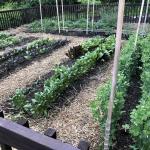Managing Weeds in Your Garden
Frank Mangan and Heriberto Godoy-Hernandez
To read individual sections of this article, click on the section headings below to expand the content:
Welcome to this tenth article of Franco and Beto’s series on growing your own vegetables and herbs in Massachusetts. In this column, we focus on managing disease problems in gardens.
Managing Weeds in Your Garden
Weeds compete with your vegetables and herbs for water, nutrients and sunlight, and will grow close to your vegetables and herbs, decreasing air movement and creating a favorable environment for diseases. In a garden, unlike with insects and diseases, you don’t need to know the Latin names of the weeds to manage them – it’s as simple as removing them with elbow grease!
 In my experience managing dozens of acres of trials at our research farm over the years, weed management in a garden is much easier compared to larger-scale production. In my trials, I use black plastic, biodegradable or not, to protect the vegetables and herbs I plant in the beds from weeds. We use tractor mounted mechanical cultivators to take out weeds in-between the beds and augment with hand-weeding in the holes of the plastic (Figure 1). Instead of plastic mulch, new paper mulches are now available, and other materials like straw, newspaper, or cardboard can also be used to prevent sunlight from getting to the weeds around your plants.
In my experience managing dozens of acres of trials at our research farm over the years, weed management in a garden is much easier compared to larger-scale production. In my trials, I use black plastic, biodegradable or not, to protect the vegetables and herbs I plant in the beds from weeds. We use tractor mounted mechanical cultivators to take out weeds in-between the beds and augment with hand-weeding in the holes of the plastic (Figure 1). Instead of plastic mulch, new paper mulches are now available, and other materials like straw, newspaper, or cardboard can also be used to prevent sunlight from getting to the weeds around your plants.
 I can easily remove weeds in my garden with hoes and by hand since it is only 700 square feet. In addition, I put mulch down between the beds (Figure 2) to smother weeds and to not allow more to germinate. I try to use salt marsh hay, when I can get it, which is harvested from saltwater marshes and has no weed seeds that can become a problem in your garden. If I can’t get salt marsh hay, I use hay harvested from fields, which can introduce weed seeds into your garden. Farm stands and garden centers will have both types. Straw is another option, which also does not have weed seeds.
I can easily remove weeds in my garden with hoes and by hand since it is only 700 square feet. In addition, I put mulch down between the beds (Figure 2) to smother weeds and to not allow more to germinate. I try to use salt marsh hay, when I can get it, which is harvested from saltwater marshes and has no weed seeds that can become a problem in your garden. If I can’t get salt marsh hay, I use hay harvested from fields, which can introduce weed seeds into your garden. Farm stands and garden centers will have both types. Straw is another option, which also does not have weed seeds.
 For weeding, I use two types of hoes, my hands, and my fingers. The hoe I use the most is called a stirrup hoe and to a lesser extent a small tined potato rake (Figure 3). The stirrup hoe will cut the roots of the weeds under the soil, thus killing them. I use the potato rake, which will also help manage weeds, mostly to prepare a section of a bed to seed or plant vegetables and herbs during the season. I also make extensive use of my fingers to get the weeds near the base of vegetables and herbs without damaging them.
For weeding, I use two types of hoes, my hands, and my fingers. The hoe I use the most is called a stirrup hoe and to a lesser extent a small tined potato rake (Figure 3). The stirrup hoe will cut the roots of the weeds under the soil, thus killing them. I use the potato rake, which will also help manage weeds, mostly to prepare a section of a bed to seed or plant vegetables and herbs during the season. I also make extensive use of my fingers to get the weeds near the base of vegetables and herbs without damaging them.